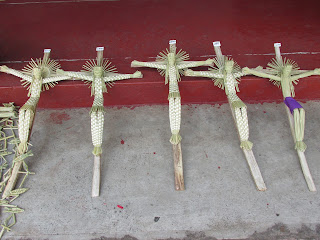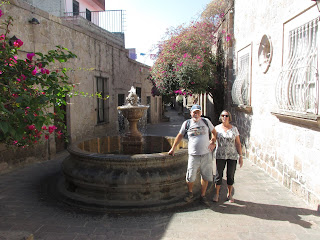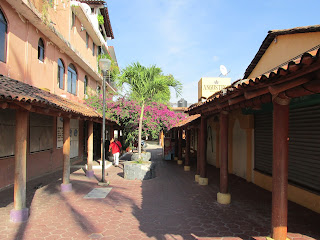Pátzcuaro was the capital of the Tarasco people from about AD 1325 to 1400. After the death of King Tariácuri, the Tarascan state became a three-part league. Comprising Pátzcuaro, Tzintzuntzan and Ihuatzio, the league repulsed repeated Aztec attacks, which may explain why they welcomed the Spanish, who first arrived in 1522. Bad idea. The Spanish returned in 1529 under Nuño de Guzmán, a vicious conquistador.
Guzmán’s reign against the indigenous people was brutal, even for those timesThe colonial government recalled Guzmán from, Spain where he was arrested and locked up for life and dispatched Bishop Vasco de Quiroga, a respected judge and cleric from, to clean up his mess. Quiroga was one enlightened dude. When he arrived in 1536, he established village cooperatives based on the humanitarian ideals of Sir Thomas More’s Utopia.
To avoid dependence on Spanish mining lords and landowners, Quiroga successfully encouraged education and agricultural self-sufficiency in the Purépecha villages around Lago de Pátzcuaro, with all villagers contributing equally to the community. He also helped each village develop its own craft specialty – from masks to pottery to guitars and violins. The utopian communities declined after his death in 1565, but the crafts traditions continue to this day. Not surprisingly, Tata Vascu, as the Tarascos called Quiroga, has not been forgotten. You’ll notice that streets, plazas, restaurants and hotels all over Michoacán are named after him.
Quiroga
Quiroga is known as the origin of the Carnitas. It's also renowned for it's crafts. We stopped in to sample some as we visited this Pueblo
Quiroga is a municipality that started before the colonial era.
Quiroga was an indispensable road from Tarazco’s capital “Tzintzuntzan” to the
ceremonial center “Zacapu”. Zacapu was known as “Cocupao” which means “Lugar de
recepción” ("Place of reception"). This municipality was not widely
known in the prehispanic era.
When the Order of the Franciscans arrived at Quiroga, they gave
it the name San Diego Cocupao, by San Diego Alcala, a name that so far leads
the parish. After the arrival of the Spaniards, it began to grow in population
leading to the city of today. Quiroga was established as a town, by territorial
law, on December 10, 1831. By decree of the State Congress on September 6,
1852, it was called Villa de Quiroga, to honor the memory of bishop of Michoacan,
Don Vasco de Quiroga.
Tzintzuntzan "Place of the Hummingbirds"
Surrounded by hills and mountains, the watershed of the state of Michoacan’s lovely Lake Patzcuaro extends 50 kilometers east-west and 33 kilometers north-south. Ringing the 2200 meter above sea level lake are numerous Purepecha (known commonly as Tarascan) villages and towns. Far and away, as it literally is about a seven hour round trip by bus from my house, my favorite of these indigenous lakeside communities that I have visited is the tiny village of Tzintzuntzan (seen Soon sahn). From my perspective (more about this later), any place with such an avian onomatopoeic name must be interesting and it delightfully is.
Approximately 50 kilometers from the state capital of Morelia this indigenous village with buildings lining its one main street made mostly from adobe painted in the traditional white wash with red trim and red tiled roofs is located 14 kilometers north from the beautiful indigenous and colonial large town of Patzcuaro and 7 kilometers from the not so beautiful crafts and carnitas/braised pork town of Quiroga. Having only a couple of hotels, Tzintzuntzan is a very popular day trip destination for Mexican tourists and to a lesser degree foreign tourists primarily on the weekends and especially during the two days of the Day of the Dead celebrations. There are three major attractions that the majority of visitors come to experience.
Just a kilometer from the center of the village on the side of a hill is the Tzintzuntzan Archaeological Site. Until the Spanish Conquistadors vanquished them in 1522, Tzintzuntzan had been the capital of the Purepecha Empire (circa 1200AD-1522AD). While always remaining autonomous from the Aztecs the empire had under its control approximately 1.5 million people at the height of its power. Now, this ex-ceremonial center with a platform measuring 425 meters by 250 meters and its 5 yacatas- the unusual Mesoamerican semi-circular bases constructed from non-mortared basalt slabs that were the foundations for the long ago destroyed wooden pyramids/temples built on top of them- is all that remains of that empire. Although not as physically impressive (nor accessible as you may not climb on any of the fenced off yacatas) as the more famous, extensive, and “inward” looking Mexican archaeological sites like Monte Alban, Chichen Itza, or Teotihuacán, I find this “outward” looking site to be visually quite compelling. From this hill with the yacatas as a unique historical backdrop one is afforded an outstanding panoramic view of the village below and of Lake Patzcuaro off in the distance. Also, there is a one room, albeit not particularly well lighted, museum near the entrance that exhibits excavated pottery/ceramics, obsidian artifacts, and a diorama of the site.
Yet, back in town, what attracts the most tourists are the crafts that the village is known for. Although its craft market next to the monastery complex and artisan stores along its main street are open seven days a week, the crafts scene is most vibrant and full with vendors on the weekends, especially Sunday. There, among a plethora of mostly locally made goods you can find woven tule/lake reeds items, both high-end ceramics and inexpensive pottery including its famous green glazed pieces, rebozos, embroidered textiles with pre-Hispanic motifs, objects made from vegetable fibers, rustic wood furniture, basketry, and dozens of items woven from straw including brilliant strands of Christmas decorations like stars, candy canes, and mini wreaths along with more straw merchandise like lamps, tortilleros/tortilla warmers, wind chimes, and sea shells. Moreover, on the road leading into town from Patzcuaro are stonework shops that have decorative and landscaping pieces made from the pinkish rock cantera like ornate fountains and whimsical-looking fish, frogs, and turtles.
However, while I enjoy all of the three major attractions that Tzintzuntzan offers, the primary reason that I travel so far to get there is for its bird watching opportunities, particularly in the winter. In the indigenous language, Tzintzuntzan onomatopoeically means “place of the hummingbirds.” While it is true that during the time of the Purepecha Empire that these diminutive birds were driven to extinction due to the desirability of their iridescent feathers for use in clothing and jewelry, it is also true that they and dozens of other species of birds now occur in Tzintzuntzan. In town the best places to view birds is at the Ojo de Agua and the small public embarcadero. The archaeological site with its pine-oak grove is also an excellent birding spot.
Whether you are a birder or not, Tzintzuntzan is an indigenous lakefront town that is well worth a visit. Who knows, while in the Zocalo and enjoying its traditional ambiance, you might experience what I did the last time that I was there --- the tz-tz-tzing of hummingbirds, tz-tz-tzing to and fro in a flower garden.
La Isla Janizio on Lago Patzcuaro
A 40-meter statue of José María Morelos, a great hero of Mexico's independence, started in 1933, is found on the island's highest point. For about 6 pesos, one can climb to the top of the statue by way of a staircase that spirals up the inside. Along the interior walls, the life of Morelos is depicted in murals painted by Ramon Alba de la Canal and other great Mexican muralists. Although the steep stairway can become congested and distract one's attention, it is a good Mexican history lesson. At the top, one can peer through peepholes in the giant raised fist of Morelos, giving a spectacular view of the island, lake and surroundings































































